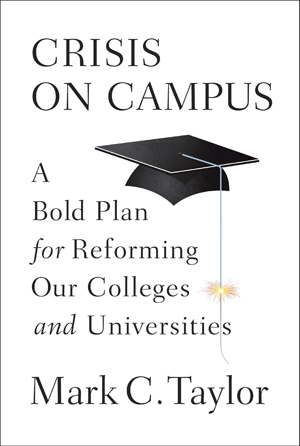
Our current system of higher education is financially, curricularly and institutionally unsustainable.
And there is no easy answer to a problem this complex.
But I wrote Crisis on Campus because no significant progress can be made until we recognize that our higher education’s problems are structural and systemic.
The American higher education landscape is vast and diverse. When considering its problems, it is necessary to understand the important role that institutions ranging from community colleges and liberal arts schools to research universities and for-profit enterprises are playing.
We must also understand that these problems are global.
One of the major hurdles to improving higher education is the American mania for ratings. That leads institutions into costly and unproductive competition.
Individual colleges and universities cannot and should not address the present crisis by themselves. Rather, they should be cooperating and collaborating from the local and state to the national and global levels.
New network technologies are one key theme in the plan I propose. These technologies now make it possible for such cooperation to no longer be limited by geographical proximity.
“One of the major hurdles to improving higher education is the American mania for ratings. That leads institutions into costly and unproductive competition.”
The book’s chapter 5 is titled “Education Bubble.”
When considering the financial problems of higher education, it is important to look at the issue from the side of both students and institutions.
The cost of college has been rising much faster than both income and the Consumer Price Index for decades—and it is approaching the breaking point. During the past 25 years, tuition and fees have gone up 440%—four times the rate of inflation. This June, the national student debt surpassed credit card debt for the first time. This fact is astonishing but its significance has not been noted.
If current trends continue, four years at a top-tier school will cost $330,000 by 2020, $580,000 by 2028 and $788,000 by 2035. Obviously, this has to change.
The problems are equally challenging for colleges and universities.
Assets are down. With the recent financial meltdown, the continuing recession, and declining government support, endowments are down, and not about to go up again in the near future.
Liabilities are increasing. Over the past two decades, many colleges and universities borrowed heavily to expand—and they are now are carrying significant debt. Costs are either fixed or rising and income cannot increase enough to maintain current operations.
The Chronicle for Higher Education recently reported on a study of 700 colleges, which concluded that 2/3 were facing a severe financial crisis—and many seemed destined to close.
While radical reform is necessary at every level of higher education, it needs to start with a thorough restructuring of graduate education and, by extension, a redesign of the curriculum for undergraduate education.
Research universities play a vital role in the life or our nation and vitality of our economy. But in far too many cases, the increasingly specialized research has led to a fragmentation of knowledge and the proliferation of courses that are of little or no use to undergraduates.
Even though the cost keeps rising, colleges and universities are not doing an adequate job of preparing students for life and work in the 21st century.
Institutions are divided into departments with subfields within subfields and faculty members who cannot or will not communicate with each other. In some areas, specialization is necessary but it has gone too far.
We need to redesign the curriculum to create possibilities for research and teaching that cut across disciplinary and cultural boundaries. We also need to do a better job of training our students in new forms of literacy that emerging technologies will require.
Graduate programs today haven’t changed much since the Middle Ages. Students are required to write medieval dissertations that will never be published or read by anyone other than their professors. This is hardly a prescription for success in today’s world.
“While radical reform is necessary at every level of higher education, it needs to start with a through restructuring of graduate education.”
Effective transformation requires a new vision for higher education. It is obvious that the world is becoming ever more interconnected and that the rate of change is accelerating.
And yet, our colleges and universities are mired in the past—they are rigid structures that resist change. The vested interests of tenured faculty make it virtually impossible to bring about the reforms that are necessary.
The future of our children and grandchildren depends on creating a global education network that is as flexible and adaptive as the world we live in.


Mark C. Taylor is a Professor of Religion, Chair of the Department of Religion and Co-Director of the Institute for Religion, Culture and Public Life at Columbia University; Professor of Philosophy of Religion at Union Theological Seminary; and Professor Emeritus of Humanities at Williams College. He received his B.A. from Wesleyan University, Ph.D. from Harvard University and was the first foreigner to be award a Doktorgrad in Philosophy from the University of Copenhagen. His many awards include a Guggenheim Fellowship, the University of Helsinki’s Rector’s Medal and Wesleyan University’s Distinguished Alumni award. In 1995, the Carnegie Foundation named Mark Taylor the National Professor of the Year for his use of technology to advance higher education. Besides the books featured in his Rorotoko interviews (Field Notes from Elsewhere and Crisis on Campus), his most recent books include After God, Confidence Games: Money and Markets in a World without Redemption, and Mystic Bones.